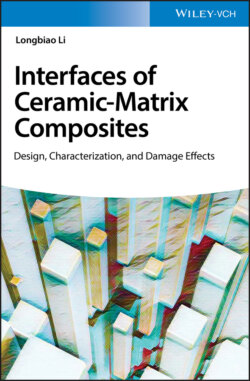Читать книгу Interface of Ceramic-Matrix Composites - Longbiao Li - Страница 10
Preface
ОглавлениеTo realize the advantages of operating systems under high temperature conditions, it is necessary to master the properties of a large number of high temperature materials and components. For example, a significant increase in the gas temperature will significantly increase the gas turbine efficiency. The introduction of new materials and new technology has gradually improved the high‐temperature performance of gas turbine engine for more than 70 years, but the development of cooling methods and solutions has contributed more than 75% to the performance improvement. Although component cooling methods and engine material properties have improved significantly, most high‐temperature alloys currently operate at temperatures above 90% of their original melting point. Higher operating temperatures are required for more efficient engines, which will require higher component temperatures. As the operating temperature continues to increase, new materials with higher thermo‐mechanical and thermo‐chemical properties are required to meet high‐temperature structural applications. Ceramic‐matrix composites (CMCs) are considered to have the potential to provide high strength, high toughness, creep resistance, low notch sensitivity, and environmental stability to meet the needs of future high‐performance turbine engines.
For a monolithic ceramic material, when it is subjected to tensile stress, it appears as elastic deformation at low stress level; as the stress increases, cracks occur in the defect region of the material, and the cracks rapidly expand, causing the material to undergo brittle fracture. When the CMC material is subjected to tensile stress, it is elastically deformed before matrix cracks; as the tensile stress increases, the matrix begins to crack, and the fibers begin to debond and play a role of crack bridging; as the tensile stress increases further, the cracks become saturated, and the bridging fibers begin to pull out; as the tensile stress continues to increase, the fibers begin to break until the material reaches the highest strength. The fracture modes of monolithic ceramics and CMCs are different, mainly because the interface plays a role in the fracture process of CMCs. The interface is a special domain between the matrix and the reinforcement. It is the link between the fiber and the matrix, and also a bridge for load transfer. The structure and properties of interphase directly affect the strength and toughness of CMCs. This book focuses on the time‐dependent mechanical behavior of CMCs at elevated temperatures, as the following:
1 (1) The definition, function, and design of interface in different fiber‐reinforced CMCs are given. The interphase plays an important role in the mechanical behavior of non‐oxide and oxide/oxide CMCs at room and elevated temperatures. The interface phase has two basic functions. One is mechanical fuse function that is to deflect crack growth to protect the fiber, which is the most basic function of the interphase. The second is the load transfer function, which transfers the load to the fiber through shear. In addition to the aforementioned two basic functions, the interphase also plays a buffer role, which is to absorb the residual thermal stress generated due to the mismatch of the thermal expansion coefficient of the fiber and the matrix. The characteristics of pyrolytic carbon (PyC) interphase and boron nitride (BN) interphase used in CMCs are also analyzed.
2 (2) The effect of the fiber/matrix interface properties and pre‐exposure on the tensile and fatigue behavior of fiber‐reinforced CMCs is investigated. The experimental tensile and fatigue damage of different CMCs are predicted for different interface properties. The fatigue life S–N curves and fatigue limit stress of unidirectional C/SiC, SiC/CAS (silicon carbide/calcium aluminosilicate) and SiC/1723 (silicon carbide/alkaline‐earth aluminosilicate), cross‐ply C/SiC, SiC/CAS and SiC/1723, 2D C/SiC and SiC/SiC, 2.5D C/SiC, and 3D C/SiC composites are predicted.
3 (3) The relationships between the hysteresis dissipated energy and temperature rising of the external surface in fiber‐reinforced CMCs under cyclic loading are analyzed. Based on the fatigue hysteresis theories considering fiber failure, the hysteresis dissipated energy and a hysteresis dissipated energy‐based damage parameter changing with the increase of cycle number are investigated. The experimental temperature rise‐based damage parameter of unidirectional SiC/CAS‐II, cross‐ply SiC/CAS, and 2D C/SiC composites corresponding to different fatigue peak stresses and cycle numbers are predicted. The fatigue hysteresis behavior of unidirectional, cross‐ply, and 2.5D C/SiC composites at room temperature and 800 °C in air atmosphere are investigated.
4 (4) Comparing experimental fatigue hysteresis dissipated energy with theoretical computational values, the interface shear stress of unidirectional, cross‐ply, 2D, and 3D CMCs at room temperature, 600, 800, 1000, 1200, and 1300 °C in inert, air, and steam conditions, are obtained. The effects of test temperature, oxidation, and fiber preforms on the degradation rate of interface shear stress are investigated, and the comparisons of interface degradation between C/SiC and SiC/SiC composites are analyzed.
I hope this book can help the material scientists and engineering designers to understand and master the interface of CMCs.
26 January 2020
Longbiao Li
